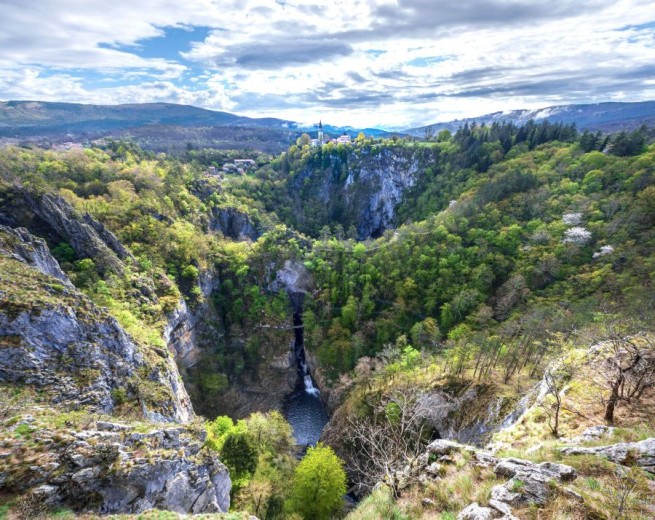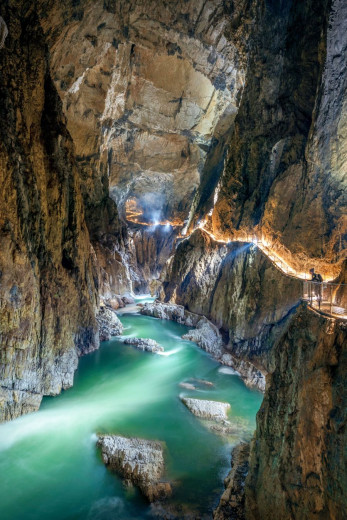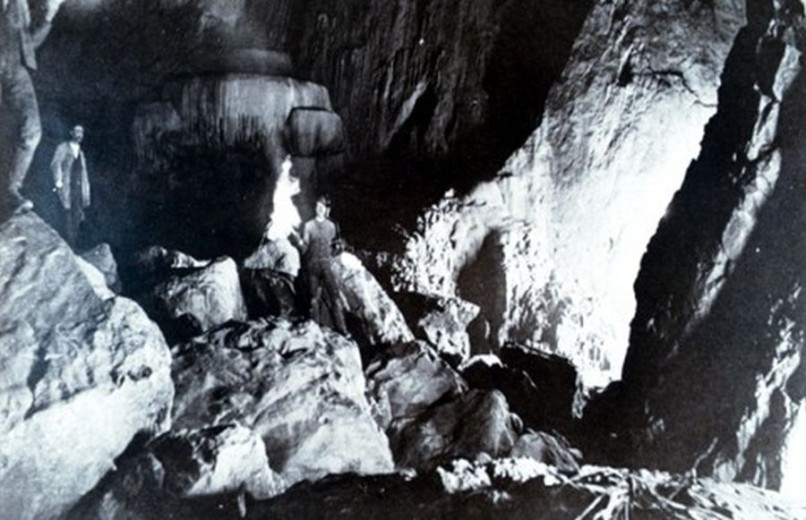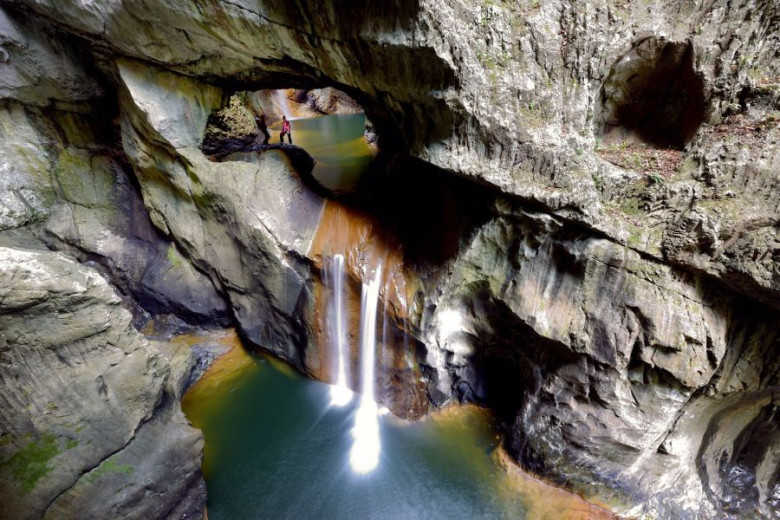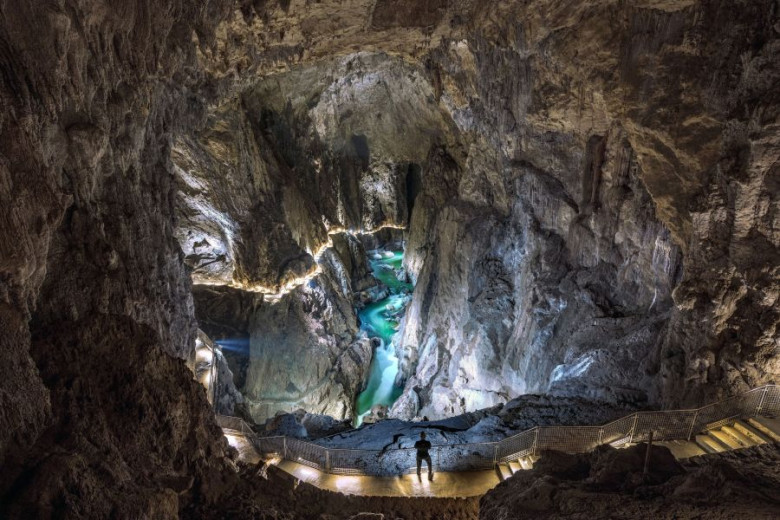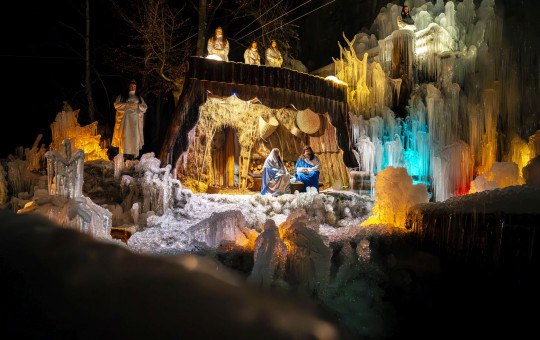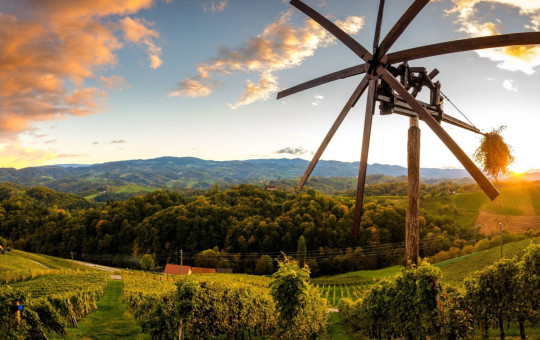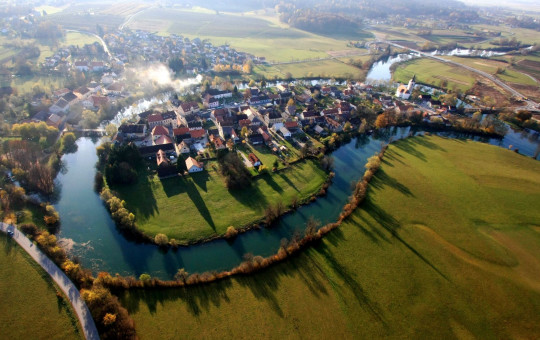Date: 24. November 2025
Time to read: 2 min
Not only are the Škocjan Caves Slovenia's first natural monument to be inscribed on the UNESCO World Heritage List, they also rank among the most fascinating and significant underground landscapes on the planet. Their sheer scale impresses every visitor, revealing rare geological formations and a living world shaped by thousands of years of natural processes.
The Reka River flows above ground for around 55 kilometres before dramatically vanishing into the underworld at Velika Dolina, only to re-emerge 34 kilometres away at the Timava Springs near the Adriatic Sea.
The Reka River blind valley is the largest in Slovenia.
Above the cave system stand the collapsed dolines of Velika Dolina and Mala Dolina, formed by the collapse of the former cave ceiling. A striking natural bridge spans the gap between them.
-
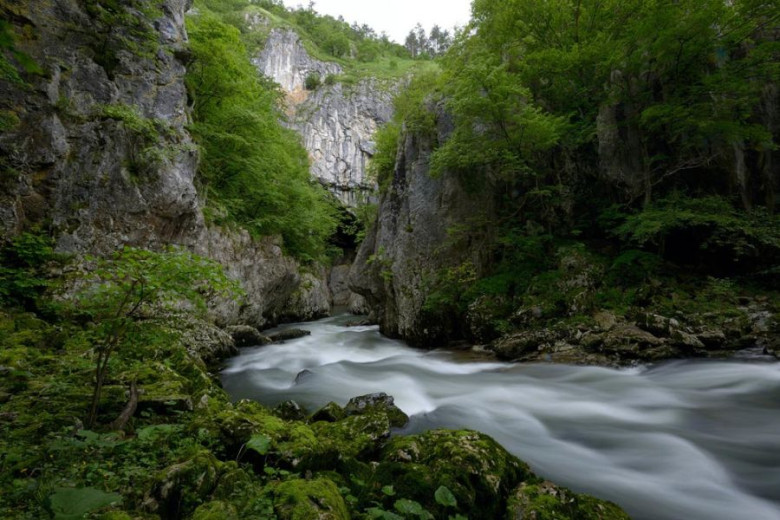 In the first part of its course on the limestone, the Reka still flows on the surface, along an approximately four-kilometre-long gorge that ends with a magnificent wall under which it disappears underground. The Reka River blind valley is the largest in Slovenia. Photo: Borut Lozej/ Park Škocjanske Jame Archive
In the first part of its course on the limestone, the Reka still flows on the surface, along an approximately four-kilometre-long gorge that ends with a magnificent wall under which it disappears underground. The Reka River blind valley is the largest in Slovenia. Photo: Borut Lozej/ Park Škocjanske Jame Archive
The subterranean canyon, known as Šumeča jama (the Murmuring Cave), is 3.5 kilometres long, between 10 and 60 metres wide, and over 100 metres high. The total length of all the cave passages is approximately 6 kilometres, while the total elevation difference between the highest entrance – the Okroglica Abyss – and the lowest siphon is 205 metres.
The cave's highlight is Martel's Chamber, a vast underground chamber 308 metres in length, with a maximum width of 123 metres and a maximum height of 146 metres. With a total volume of 2.2 million cubic metres, it is considered as one of the largest known underground chambers in the world. Despite its vast dimensions, the entire canyon narrows into a relatively small siphon that cannot contain all the water during periods of heavy rainfall. Consequently, floodwaters inside the caves can sometimes rise to a height of over 100 metres.
Exploring the Škocjan Caves
Stories about the Reka River sinkhole date back to ancient times. The caves are referenced in historical documents and depicted on early maps. They were also vividly described by Janez Vajkard Valvasor, the 17th-century polymath and chronicler of Carniola. In the 19th century, the search for new water sources for the city of Trieste spurred systematic exploration of the underground river. Researchers and miners forced their way through the gorge, followed the waterfalls and mapped the passages.
In 1890, they reached Mrtvo jezero (Dead Lake), where they discovered the Martel Chamber.
A turning point in the exploration of the Škocjan Caves was the establishment of a speleology division by the Primorska Section of the German and Austrian Mountaineering Society of Trieste, which acquired the lease to the caves and began to research them systematically and lay out visitor paths. This was followed by the discovery of Tiha jama (Silent Cave) in 1904. In 1991, divers discovered new passages behind the Mrtvo jezero with an underground river and lakes.
This marked the beginning of modern cave tourism. The first steps into Velika Dolina were built in the early 19th century and a visitor book has been kept since 1819.
Locals from Škocjan and Matavun painstakingly chiselled over 10 kilometres of trails throughout the entire cave system with their own hands. Using basic tools such as wedges and wires, they constructed wooden bridges and galleries directly into the sheer walls above the river. This vertical network of walkways and bridges enables visitors today to safely admire scenes that were considered nearly inaccessible just a century ago.
Evidence of continuous human settlement spanning at least the last 5,000 years has been found at the sites of Mušja Cave, Tominčeva Cave, and the surrounding area.
Archaeologists have discovered over 600 metal artefacts, weapons and animal bones from the late Bronze Age in the 50-metre deep abyss of the Mušja Cave. These artefacts provide evidence that sacrificial rites to gods were performed above the cave. People made pilgrimages to this cult centre from areas of present-day Italy, the Alps, the Pannonian Plain, the Balkans and Greece. The magnificent entrances to the underworld and the river's disappearance gave the area symbolic significance comparable to that of the legendary Homeric underworld.
A living laboratory of nature
The Škocjan Caves are remarkable not only for their geology and history but also for the vibrant ecosystem alive within them. Shaped by a unique microclimate, Velika and Mala Dolina are a true natural experiment.
Within just a few dozen metres of elevation, plants typical of both Ice Age habitats and the warm Mediterranean coexist side by side.
The cool, shaded walls at the bottom of Velika and Mala Dolina are home to glacial relics such as alpine auricula (Primula auricula), crusted saxifrage (Saxifraga crustata), Viola biflora and Kernera saxatilis. A few dozen metres higher up, in the ceiling of the entrance to Schmidl Hall, thriving thermophilic species can be found, including maidenhair fern (Adiantum capillus-veneris), wild asparagus (Asparagus acutifolius) and prickly juniper (Juniperus oxycedrus). The regional park is home to numerous sub-Mediterranean plants, grassy areas and scrubland. It hosts unique, rare, and endangered habitats, including several endemic species that are found nowhere else in Slovenia or this is their only habitat.
The steep cliffs of collapsed dolines periodically shelter and provide nesting places for rock doves (Columba livia), colonies of alpine swifts (Tachymarptis melba), eagle owls (Bubo bubo), peregrine falcons (Falco peregrinus) and common ravens (Corvus corax). In winter, the cracks provide shelter to alpine wallcreepers (Trichidroma muraria). The park's surroundings bring together habitats for forest and meadow birds, ranging from hygrophilous bird species at the bottom of collapsed dolines to thermophilic bird species, such as different kinds of yellowhammers (Emberiza), shrikes (Lanius) and larks in higher, more open areas. Among the mammals commonly found here are dormice, foxes and badgers. The caves also shelter important bat colonies, including Schreiber's long-fingered bat (Miniopterus schreibersii) and the long-legged bat (Myotis capaccinii), each of which once numbered several thousand individuals.
The subterranean ecosystem is even more hidden. As there is no light in the caves, so green plants cannot survive there. The only food available is organic matter that has washed down from the surface.
Despite the harsh conditions, specialised animals known as troglobionts have evolved here.
They are completely unpigmented and often blind, with highly developed sensory organs and a slow metabolism that allows them to live exceptionally long lives. On land, the fauna is dominated by tiny beetles, spiders, pseudoscorpions and cave woodlice, while the waters are home to various species of small crustaceans.
The most famous inhabitant of the subterranean waters is the olm, also known as the human fish. It can grow to over 20 centimetres in length and is regarded as one of the first cave organisms to be scientifically described in the world. At the entrance sections of the Reka River, the surface and subterranean worlds still meet, providing a habitat for insect larvae, small crustaceans, worms, mites and other tiny organisms. Slovenia is one of the world leaders in terms of the richness of its subterranean fauna, and the Škocjan Caves are a key centre for this exceptional living laboratory.
-
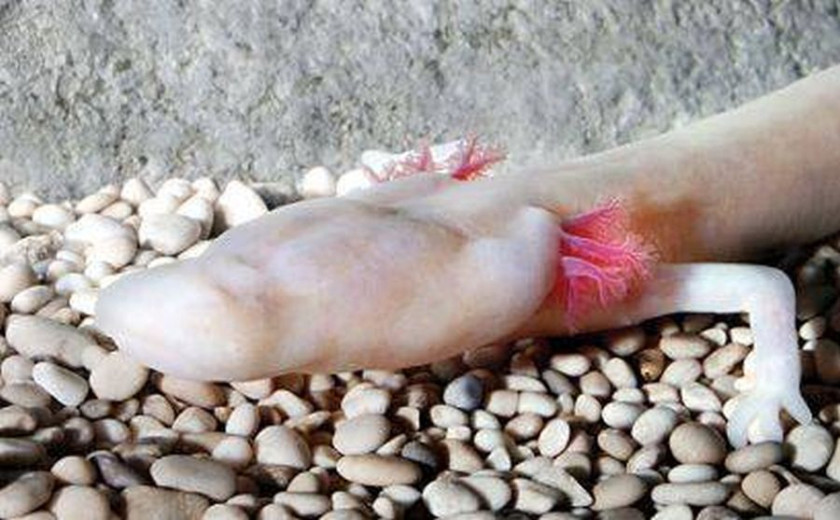 They eat, sleep, and breed underwater. Feeding on crustaceans like shrimp, insects and snails. Olm are only found in underground cave systems in the Balkans and are Europe's only cave-adapted vertebrate, but despite being thought to live more than 100 years, they reproduce just once or twice per decade. Photo: Wikipedia
They eat, sleep, and breed underwater. Feeding on crustaceans like shrimp, insects and snails. Olm are only found in underground cave systems in the Balkans and are Europe's only cave-adapted vertebrate, but despite being thought to live more than 100 years, they reproduce just once or twice per decade. Photo: Wikipedia
-
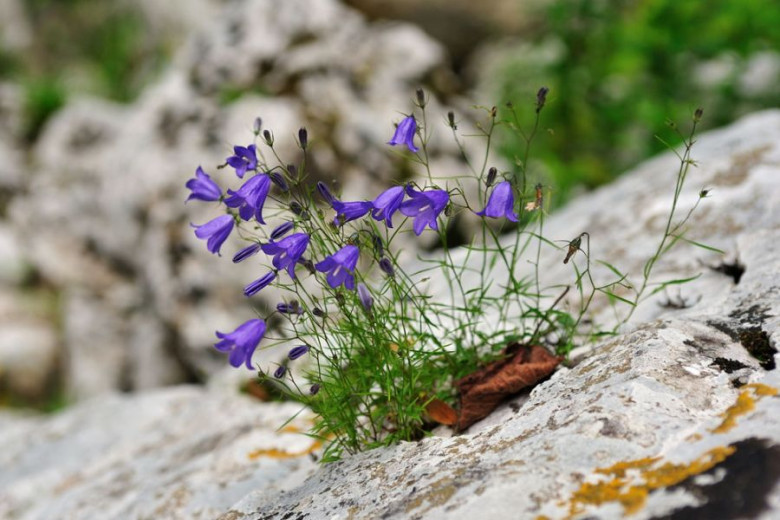 Justin's bellflower (Campanula justiniana) sprouts from underground parts, producing numerous upright stems. These are slender and typically hairless. The stem leaves are alternately arranged. The lower leaves, ovate to lanceolate, are long-petioled, their leaf margins serrated with a few sharp teeth. Photo: wikipedia
Justin's bellflower (Campanula justiniana) sprouts from underground parts, producing numerous upright stems. These are slender and typically hairless. The stem leaves are alternately arranged. The lower leaves, ovate to lanceolate, are long-petioled, their leaf margins serrated with a few sharp teeth. Photo: wikipedia
UNESCO World Natural Heritage List
Slovenia's subterranean world is threaded with dramatic canyons, mysterious passages and monumental stone chambers, which reveal a narrative spanning millions of years between rock and water. These cave systems serve as both natural laboratories and cultural archives, preserving the unique heritage of the local landscape.
The Škocjan Caves were inscribed on the UNESCO World Natural Heritage List in 1986.
They were later added to the Ramsar List of Wetlands of International Importance, becoming the world's first underground wetland to receive this designation.
The Škocjan Caves Regional Park was established in the 1990s with the mission to ensure conservation, research, education, promotion and cooperation with local communities. What was once a demographically and economically threatened karst area has been given a new lease of life: rather than being exploited inappropriately, the region is now being developed based on scientific knowledge of the karst landscape and a profound respect for nature. The tourism products and services here have been shaped according to the same principles.
The Škocjan Caves are a stunning natural amphitheatre and a living classroom, offering visitors extraordinary insights into the underground world.
Every step through the caves reveals a fragile and unique world beneath your feet, a world that consistently inspires visitors with the sheer power of nature and the vastness of time.

